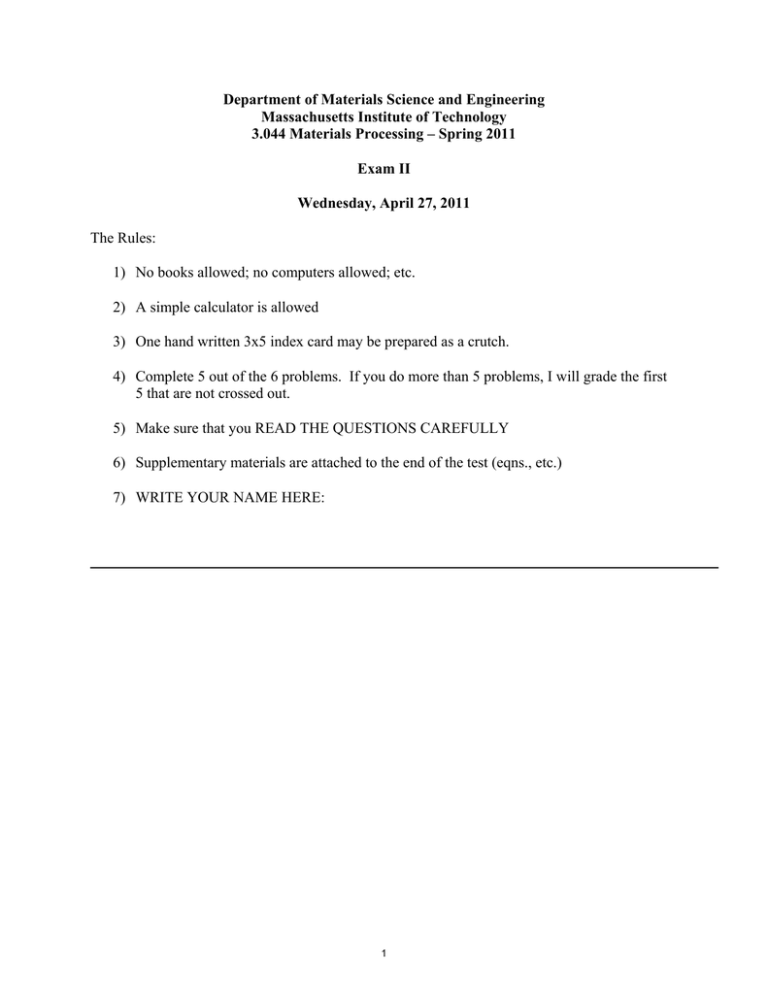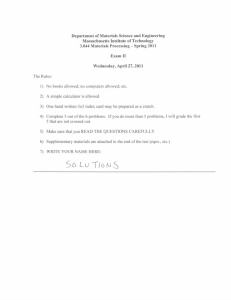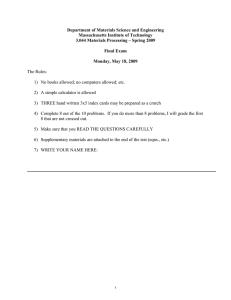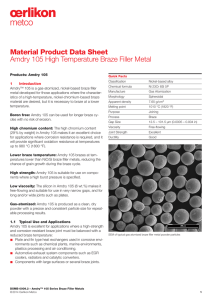Department of Materials Science and Engineering Massachusetts Institute of Technology
advertisement

Department of Materials Science and Engineering Massachusetts Institute of Technology 3.044 Materials Processing – Spring 2011 Exam II Wednesday, April 27, 2011 The Rules: 1) No books allowed; no computers allowed; etc. 2) A simple calculator is allowed 3) One hand written 3x5 index card may be prepared as a crutch. 4) Complete 5 out of the 6 problems. If you do more than 5 problems, I will grade the first 5 that are not crossed out. 5) Make sure that you READ THE QUESTIONS CAREFULLY 6) Supplementary materials are attached to the end of the test (eqns., etc.) 7) WRITE YOUR NAME HERE: 1 Problem #1: Swimming for Their Lives (the particles, not the students) In continuous casting, one major problem is that small inclusion particles can be caught in the casting. Let’s analyze this problem, for small inclusions of Al2O3 (which are actually quite common in steel). The key consideration is that the alumina particles float in molten steel. For such a particle in the melt region at point ‘A’, the particle is (a) trying to float to the top due to the buoyancy force (F = Δρ·g·V, with V the particle volume), (b) but being propelled downward at the casting velocity vc (= 1 m/min) at the same time. melt Particle ‘A’ solid metal vc Part A: Write down a reasonable and simple condition that decides whether the particle will eventually escape at the top surface, or be carried down and get incorporated in the metal in the sump. Part B: Let’s calculate the velocity at which the particle would rise. Write down the force balance for particle ‘A’, and indicate with what velocity it rises. (For this part of the problem, ignore the vc effect.) Part C: Some particles will escape, and some will not—calculate which size particles will escape and which will not. You may need the information at the back of the test, and the viscosity of the melt is 7·10-3 Pa·s. 2 Problem #2: A Question you are in a Super Position to Answer It is sometimes possible to use the principle of superposition for fluid flow problems. (Of course this is no surprise, seeing the pervasive analogies between flow and diffusion.) Below are some common situations in fluid flow. Explain whether or not you can use superposition to solve for the flow field in each case. If superposition is possible, explain what geometries/solutions are superposed. If it is not possible, explain why not. Part A) Fluid is pumped down a pipe of square cross-section. Part B) Gravity drives flow down a rectangular channel open to the air on top. Part C) A cylinder of aspect ratio 1 is filled with water, closed, and spun on its axis, leading to rotational flow of the liquid inside. 3 Problem #3: The Students Face Down a Real Phase Diagram You are given a rod of titanium that contains 1 at% cobalt, and asked to purify it. Looking at the Ti-Co phase diagram, you reason that this alloy could be zone refined, exactly as discussed in your 3.044 class. You place the rod into an induction coil and pull it through slowly, locally melting and resolidifying the rod as the hot zone passes over it. At the end of one pass, you analyze the leading end of the rod—this is the first part of the rod to be melted and resolidified. Part A: From the phase diagram, you estimate that the alloy composition at the end of the bar should be about 0.6 at% after one pass through the zone refiner. Explain this estimate. Part B: You are shocked to find, however, that the end of the bar is quite substantially purer than you first suspected it might be! The composition is ~0.1 at% Co. Explain why the rod is so pure at this end, and why specifically it is at a value near 0.1 at% Co. (Note: your measurements are made after the rod is cooled back down to room temperature). 4 Problem #4: Which Driving Force is Doing the Driving? In class, a long time ago, we looked at the problem of glass fiber production. We explicitly looked at the required cooling rate to keep a new fiber of diameter 20 µm, drawn from the fluid, from breaking up into droplets before it became rigid. A schematic of the process in shown at the right. Now, back when we looked at this problem, we knew heat transfer but not fluid flow. Let’s talk about fluid flow this time around. Molten glass 1 cm 20 m Information: the material is glass at 900° C, µ = 102 Pa·s, ρ = 2500 kg/m3, γ = 0.5 J/m2. Part A) There are two driving forces for flow of the molten glass through the aperture. Name them, and determine which is dominant. Part B) There is one driving force for the breakup of the stream into droplets: capillary stress, σ = 2γ/r. Compare it to the driving forces from Part A and convince yourself (and me) that it is significant in this process. Pay attention to units here. 5 1m Problem #5: Stretchy or not so Stretchy? Polyethylene is a very nice material to form into shapes with viscous forming operations. At the right are data for the rheology of polyethylene. NOTE: These data are plotted on LOGARITHMIC SCALES. The slope tells you about the strain rate sensitivity. Part A) For a fixed forming rate (a shear rate of, say, 10 s-1), higher temperatures lead to more stable flow. Provide an estimate of the tensile ductility at 300º C vs. 120º C. Part B) As a process designer, you would like to operate at the lowest possible temperature and the highest possible rate. Explain briefly how, with the help of this data, you would identify an optimum processing condition? What data would you need to do such an analysis? 6 Problem #6: Amazing Brazing Copper Braze alloy Copper A B The process of brazing is essentially like casting: a melt is placed between two objects to be joined; the melt then solidifies, holding the objects together. These pictures show cross-sections of braze joints between two copper pieces (which are on the top and bottom). Here are three variables in this process: (i) braze alloy composition, (ii) thickness of the braze region, (iii) temperature of the copper sheets. Part A) If (i) and (ii) are exactly the same between the two cases A and B, explain how (iii) must be different between them. Provide one sentence of physical explanation. Part B) If (ii) and (iii) are exactly the same between the two cases A and B, explain how (i) must be different between them. Provide one sentence of physical explanation. 7 MIT OpenCourseWare http://ocw.mit.edu 3.044 Materials Processing Spring 2013 For information about citing these materials or our Terms of Use, visit: http://ocw.mit.edu/terms.








